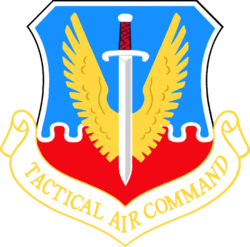Bergstrom Air Force Base
Bergstrom Air Force Base (1942–1993) was located seven miles southeast of Austin, Texas. In its later years it was a major base for the U.S. Air Force's RF-4C reconnaissance fighter fleet.

| Bergstrom Air Force Base Del Valle/Bergstrom Army Airfield  | |
|---|---|
| Part of Strategic Air Command/Tactical Air Command | |
| Austin, Texas | |
 Aerial view of Bergstrom Air Force Base | |
 Bergstrom AFB | |
| Coordinates | 30°11′40″N 097°40′12″W |
| Type | Air Force Base |
| Site information | |
| Owner | City of Austin, Texas |
| Condition | Civil Airport |
| Site history | |
| Built | 1942 |
| In use | 1942–1993 |
- For the civil use of this facility and airport information, see Austin-Bergstrom International Airport
History
Bergstrom was originally activated on 19 September 1942, as Del Valle Army Air Base. The United States Army leased 3,000 acres (1,200 ha) from the city of Austin, on land acquired from the Santiago Del Valle Grant.[1] The Chisholm Trail ran through the tract. The name of the base was changed to Bergstrom Army Air Field on 3 March 1943, in honor of Austinite Capt. John A. E. Bergstrom, who was killed at Clark Field, Philippines. The base was renamed Bergstrom Field on 11 November 1943, and became Bergstrom Air Force Base in December 1948. Initially, Bergstrom was the home of troop-carrier units. It was declared a permanent base after World War II and was at various times assigned to the Strategic Air Command and the Tactical Air Command. After July 1966 it was under the control of the Tactical Air Command and housed the headquarters for the Twelfth Air Force, which was responsible for all Tactical Air Command reconnaissance, fighter, and airlift operations west of the Mississippi River.[2][3]
In the 1960s, Bergstrom Air Force Base became the place where Air Force One flew into and out of often. It was the airfield that Lyndon Johnson flew into and out of when president when traveling between Washington and his ranch in Texas.
During the 1970s, Austin's tiny municipal airport became crowded and noise complaints increased. The city approached the Air Force in 1978 to propose a shared civil-military airport at Bergstrom, but the original proposal and further ones in 1981 and 1984 were all rejected. In 1979 the Concorde visited Bergstrom, followed by the Space Shuttles Columbia and Discovery aboard their carrier aircraft in 1981 and 1985, respectively.
In 1990, Bergstrom ended up on a list of 75 military facilities under study for closure by the post-Cold War Base Realignment and Closure Committee. On 30 September 1993, Bergstrom was officially closed and a bond was raised for Austin-Bergstrom International Airport. Much of the former air base, including buildings, trees, and structures, were completely demolished, with a few exceptions, such as the circular Twelfth Air Force Headquarters building (which was converted into a hotel) and the original 12,250-foot runway. Air cargo operations began in June 1997 and passenger operations started in May 1999.
See also
- Central Air Defense Force (Air Defense Command)
- Texas World War II Army Airfields
- I Troop Carrier Command
References
![]()
- United States Department of Interior (April 1996). "Rural Development and Building Traditions in Southeastern Travis County: 1846–1946". Historic and Architectural Resources of Southeast Travis County, Texas. Retrieved 7 July 2019.
- Leatherwood, Art. "Bergstrom Air Force Base". Handbook of Texas Online. Retrieved 22 October 2019.
- "Del Valle Army Air Base (Bergstrom Air Force Base) Historical Marker". Retrieved 22 October 2019.
- Handbook of Texas Online
- Bergstrom AFB Memorial in the concourse of Austin Bergstrom International Airport
- Donald, David (2004) Century Jets: USAF Frontline Fighters of the Cold War. AIRtime ISBN 1-880588-68-4
- Endicott, Judy G. (1999) Active Air Force wings as of 1 October 1995; USAF active flying, space, and missile squadrons as of 1 October 1995. Maxwell AFB, Alabama: Office of Air Force History. CD-ROM.
- Martin, Patrick (1994). Tail Code: The Complete History of USAF Tactical Aircraft Tail Code Markings. Schiffer Military Aviation History. ISBN 0-88740-513-4.
- Maurer Maurer (1983), Air Force Combat Units of World War II, Office of Air Force History. ISBN 978-0-405-12194-4
- Menard, David W. (1993) USAF Plus Fifteen: A Photo History, 1947–1962. Schiffer Publishing, Ltd. ISBN 0-88740-483-9
- Mueller, Robert (1989). Active Air Force Bases Within the United States of America on 17 September 1982 USAF Reference Series, Maxwell AFB, Alabama: Office of Air Force History. ISBN 0-912799-53-6
- Ravenstein, Charles A. (1984). Air Force Combat Wings Lineage and Honors Histories 1947–1977. Maxwell AFB, Alabama: Office of Air Force History. ISBN 0-912799-12-9.
- Rogers, Brian (2005). United States Air Force Unit Designations Since 1978. Hinkley, England: Midland Publications. ISBN 1-85780-197-0.
- Joe Baugher's Encyclopedia of American Aircraft
- USAAS-USAAC-USAAF-USAF Aircraft Serial Numbers—1908 to Present
- Strategic-Air-Command.com
External links
| Wikimedia Commons has media related to Bergstrom Air Force Base. |
